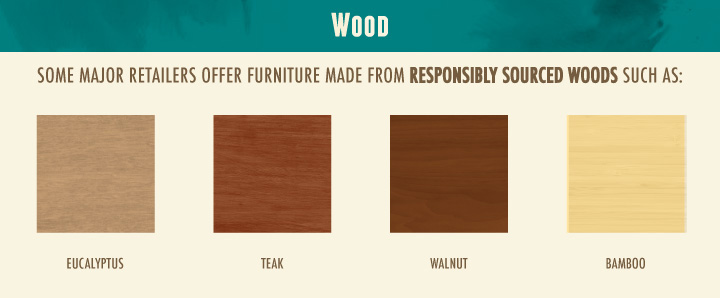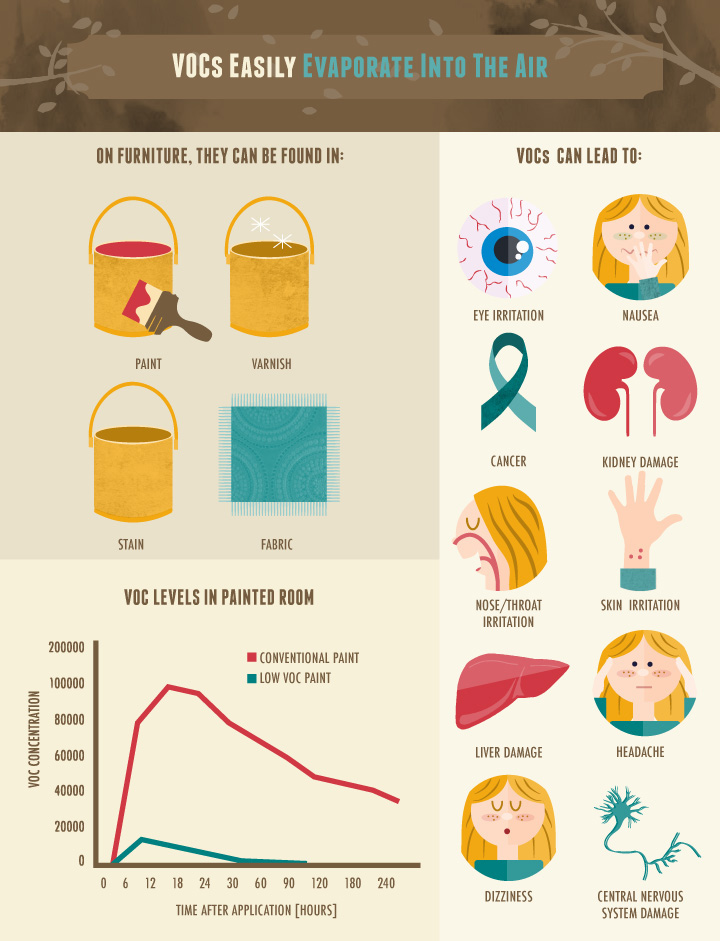How to Make Sustainable Furniture Choices
For budget-conscious consumers, frequent movers, or first-time renters, furniture meant to stand the test of time doesn’t exactly sound feasible. A $30 coffee table, $200 bed frame, and $150 dresser may sound enticing, but as many of us have found out the hard way, these particleboard wonders weren’t exactly built to last.
The primary issue with cheap, dispensable, slap-together-in-a-1-2-3 furniture isn’t just what it’s made of (we’ll get to that shortly). The bigger problem: It’s easy to chuck it. When there’s a low upfront investment, we may not be as attached to a set of inexpensive side tables as compared to heirloom oak ones. If it teeters, wobbles, breaks, or doesn’t fit a room’s changing design aesthetic, the simple solution is to toss furniture to the curb and buy new, right?
Though bargain-basement furniture offers a temporary solution, investing in replacements every few years can put a damper on your wallet and the environment. Read on for tips, from choosing sustainably sourced materials to giving old items another go, to help make your home just a little bit more green, and not just in the short term.
Choose Sustainable Materials
When purchasing new or used furniture, look for hearty materials that can handle years of use (take into account normal wear and tear from kids, pets, and moves from one home to another).
 Wood
Wood
While chopping down trees to furnish your home isn’t inherently sustainable, there are some better wood choices than others. First off, keep an eye out for timber harvested under the Forest Stewardship Council (FSC) guidelines. On paper, an FSC certification means the wood was sourced in compliance with local laws and with respect for the rights of indigenous peoples, but it’s not always foolproof. Unfortunately, since there are a number of ways illegally-logged wood and wood products can sneak past rules and regulations, the FSC label is currently just step in the right direction. Some major retailers offer furniture lines made from responsibly sourced woods such as teak, bamboo, walnut, and eucalyptus. Though wood isn’t as easily recycled as some other materials, it’s long lasting and can be sourced locally.
Veneer: a thin layer of nicer wood applied over cheaper wood. Can be used in expensive furniture as well, but limits the amount of times it can be refinished.
Plywood: layers of wood glued together, then coated with veneer
Particleboard: flakes of wood and sawdust molded together by high pressure and glue
Fiberboard: like particleboard but made with wood-pulp fibers instead
Laminated wood: a weaker type of plywood comprised of thin layers of wood
 Bamboo
Bamboo
Bamboo is gaining praise as one of the smartest, eco-friendliest furniture choices available. While a tree may require dozens of years to reach a suitable size to complete a farmhouse dining table, bamboo is very fast growing. Technically a grass, bamboo can reach anywhere from 18 to 47 inches in a 24-hour period; compare that to the decades it takes for conventional lumber-producing trees to become harvestable. It also releases 35 percent more oxygen than the equivalent of forest trees. And when it comes down to bamboo’s use in furniture, the material is seriously durable—it’s stronger than mild steel.
 Rattan
Rattan
Regularly sold as wicker furniture, rattan is especially durable when woven and is slow to show wear and tear. Since rattan is a member of the palm family, it grows much more rapidly than wood (much like bamboo).
 Metal, Steel, and Aluminum
Metal, Steel, and Aluminum
While the manufacturing of metal, steel, and aluminum may not be so green—production often requires tons of electricity—all of these materials can be easily recycled when it’s time to move on to new furniture. They’re also durable and sometimes already made of recycled content.
The materials used to make furniture are only one part of the equation. Though it’s an added challenge, it’s also a good idea to purchase furniture from companies dedicated to reducing their environmental impact. Herman Miller and Steelcase, for example, are both committed to the Cradle to Cradle Framework, making eco-effective decisions, such as powering all operations with 100 percent renewable energy. A little research into sustainable business practices can help you make a more informed purchasing decision.
 Ditch Toxic Chemicals
Ditch Toxic Chemicals
A lot of furniture is manufactured with volatile organic compounds (VOCs), which are chemicals used in things like paint, leather treatments, upholstery, plywood, and pressed wood products. VOCs leach into the air in the form of a gas. New furniture slowly releases VOCs in a home’s air over time, gradually building up to toxic levels when all doors and windows are closed. Exposure to VOCs has been associated with allergies, respiratory irritation, developmental and reproductive issues, and neurologic effects. Pre-owned furniture often releases fewer VOCs since it has already had the chance to off-gas (in other words, release all that toxic stuff). If you plan to refinish furniture, look for low VOC paints and stains.
Stain-resistant and flame-retardant fabrics are also raising concerns about potential harmful health effects. Upholstery treated with stain-resistant coatings often contains perfluorochemicals (PFCs). While the jury is still out on just how dangerous they are, PFCs have been linked to tumor growth, reproductive problems, and changes in liver and thyroid function. Keep an eye out for GREENGUARD certified products (mostly just office furniture suppliers for now), which signify furniture with low chemical emissions.
The foam inside couches, chairs, and other upholstered furniture is often doused with flame retardant chemicals. Despite their name, flame retardants have actually been found ineffective in preventing furniture fires. During manufacturing and with use over time, these chemicals are released into the air we breathe, and then accumulate in our blood stream. Studies suggest exposure to flame retardants may lead to reproductive issues, cancer, autism, and obesity. Though the chemicals aren’t completely unavoidable, look for the TB117-2013 tag and check with furniture retailers to verify purchases are free of flame retardants. Furniture without filling, including most items made from wicker, wood, and metal, are unlikely to contain dangerous flame retardants.
Learn to Love Pre-Loved
The term pre-owned often carries a negative connotation, but a little wear and tear on furniture isn’t the same as say, a car. Trolling Craigslist, tag sales, and flea markets can unearth all sorts of gems, generally within a low price bracket. Be sure to check out the furniture before you buy to make sure any damage is easy to conceal or repair. Again, you want to look for durable pieces that will last from move to move. Vintage furniture may even be better made than new stuff especially with dovetail joints and solid wood. Another option? Repurposing. A little elbow grease and some fresh paint or stain can freshen up hand-me-down furniture or tag sale finds without a major financial investment.
If the hunt for the perfect pre-loved piece (complete with a few dings and scratches) isn’t exactly your idea of a good time, there are other ways to go vintage. Many furniture makers and designers are breathing new life into scraps and reclaimed materials to create beautiful pieces. Turning to old doors, windows, beams, and even sinker wood (logs harvested from river and lake bottoms) means the furniture is at least partially made without having to cut down new trees.
Look Close to Home
One of the ultimate steps toward sustainability lies in sourcing your furniture from local makers. Shopping for furniture locally helps reduce transportation waste as well as some of the processing and packaging necessary to ship items from a far away land to your door. As an added bonus, statistics show local, independent makers are more likely to reuse materials. Purchasing American-made furniture is also a smart choice. Plenty of U.S. retailers carry furniture made from countries all over the world, meaning they may come with a considerable carbon footprint. Close-to-home purchases have the added benefit of stimulating the local economy. To put it into perspective, local business generate 70 percent more local economic activity per square foot than big box retailers. Check out local papers and classified sites for locally made items or look for an American-made label.
 Conclusion
Conclusion
While a low price tag is appealing, remember to think long term both for your finances and Mother Earth. You may be hard pressed to find a perfectly earth-friendly item, but it doesn’t hurt to make strides toward lasting, greener purchases. And remember, in the end quality materials trump just about all else.
When it is time to send your not-so-treasured nightstand to the furniture graveyard, take the extra step to dispose of it in an environmentally conscious way. An estimated 8.8 million tons of furniture ended up in U.S. landfills in 2005 alone. Recycle, sell, donate, or even refurbish furniture rather than sending it straight to landfills.
If you enjoyed this article and would like to add sustainable furniture to your home, check out these walnut dining tables — http://www.custommade.com/design-ideas/modern-black-walnut-dining-room-dining-table/







